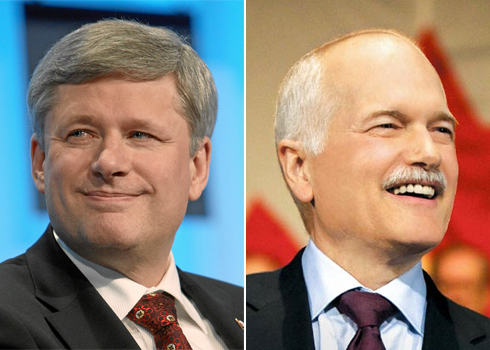Monday’s national election in Canada proved to be a decisive, historic turning point in the politics of America’s largest trading partner and neighbor to the north. Prime Minister Stephen Harper’s Conservative Party won an outright majority of seats for the first time in his five years of governing the country. But perhaps even more importantly, what had been a multi-party system for many decades, spanning the right, middle and left, now appears to be realigning to a simple two-party system of the right versus the left.
The Liberal Party, which governed from both the center and center-left for most of the 20th century and with many significant accomplishments, fell to third place in a national election for the first time in their history, seemingly supplanted by the more social democratic and labor union-affiliated New Democrats (NDP) as the party of opposition to the Tories. And as for the left-wing secessionist Bloc Quebecois, their cause of Quebec separatism has suffered a thorough defeat, with the province’s cultural nationalism certainly not going away, but instead now being represented from the left by the unionist NDP.
With all seats now projected by the Canadian Broadcasting Corporation, the Conservatives won 39.6% of the vote and 167 seats, a gain of 24 seats to put them above the 155 magic number needed for a majority in Parliament. The NDP rocketed to 30.6% and 102 seats, up from the mere 37 they had at the last election. The Green Party also won a single seat, too. And the big two losers were the Liberals, who took only 18.9% of the vote and 34 seats — down from the 77 they won last time, which was itself viewed as an awful result for them — and the Bloc Quebecois, which within Quebec only fell from 38.1% and 49 seats (out of 75) to 23.4% and a mere four seats this time, as the NDP went from just one to 58 seats in the province.
In addition, both Liberal leader Michael Ignatieff and Bloc leader Gilles Duceppe lost their seats in Parliament — Ignatieff losing by five points to a Conservative, and Duceppe losing by 11 points to the NDP candidate. Duceppe resigned as Bloc leader on Monday night, and Ignatieff — who initially said he would stay on as long as the party wanted him — announced on Tuesday that he is quitting as Liberal head.
One might be quick to suspect that the NDP and Liberals split the anti-Harper vote, delivering a lot of districts into the Conservative column. But in fact, a review of the districts themselves shows that this happened in surprisingly few cases — perhaps enough to just put Harper over the majority line, but maybe not. The Conservatives won most of their districts with outright majorities or very strong pluralities, and with the Liberals reduced to being a marginalized middle party it is unclear whether the NDP could have achieved a majority with the support of a large enough portion of Liberal voters.
So how did things go so wrong for the Liberals? They have had losses before, including some very bad ones. But throughout the past century — as TPM noted in a guide to the election — they were very much the institutional party of government, only rarely losing to the Conservatives after blunders had piled up, and then returning to office after a few years of cleaning up their act. This time, it appears that they deeply misjudged the political needs of the moment, and created an enormous opening for the NDP to overtake them.
Starting back in the 1960s, the traditionally centrist Liberals shifted leftward and co-opted many of the NDP’s issues, first under Prime Minister Lester Pearson, and then especially so under the long-serving Prime Minister Pierre Trudeau (who had previously been an activist with the NDP’s radical socialist predecessor, the Co-Operative Commonwealth Federation, and had only been a member of the Liberals for three years when he was elevated to the top job). After a big defeat in 1984, the Liberals shifted back to the middle in the 1990s, with fiscal austerity and pro-business policies under Prime Minister Jean Chretien.
But then in the last few years, when it was again clearly necessary to shift leftward and impress progressive voters, the party instead picked the decidedly centrist Ignatieff as leader, sealing their fate to be squeezed out between the right and left.






